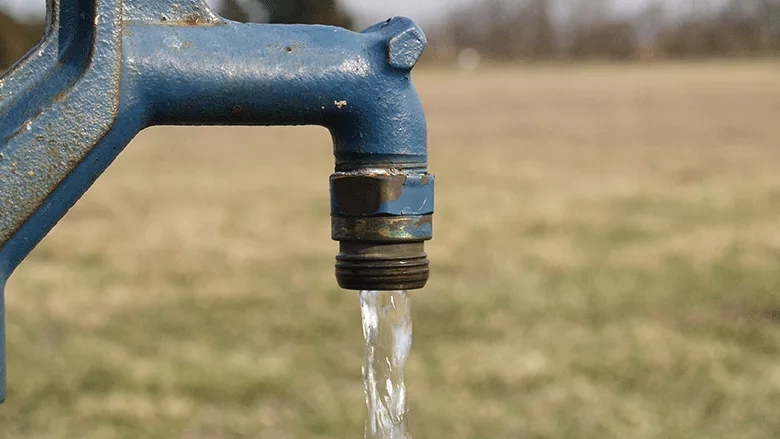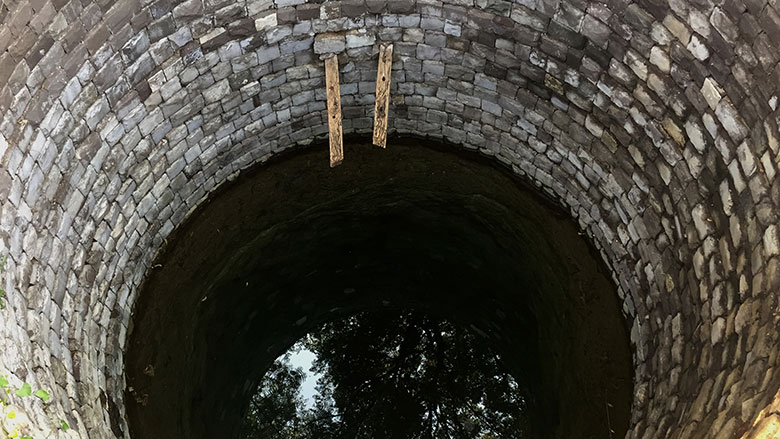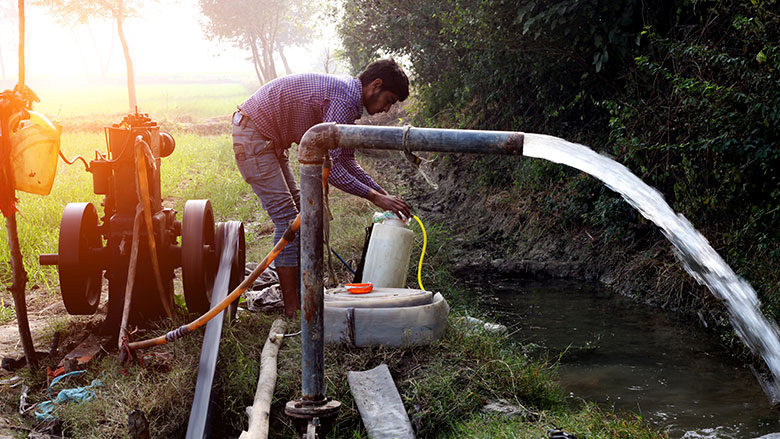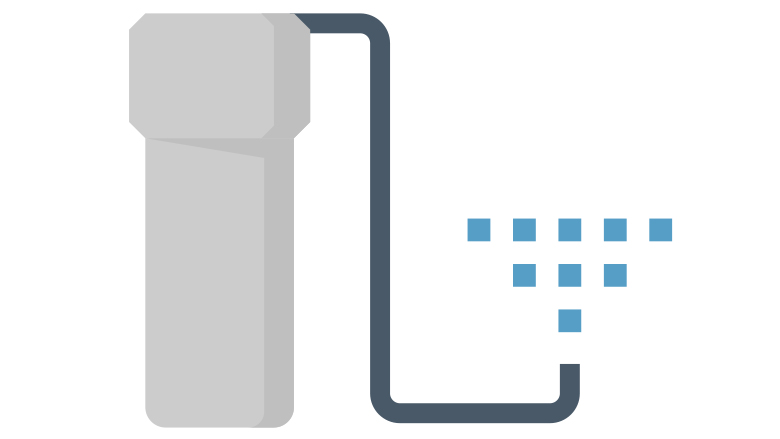Irrigation Well Basics

Photo: nreighard / E+ via Getty Images
Effective irrigation is not possible without a reliable water source. Irrigation wells must produce a high volume of water during the driest months of the year, July and August. To maintain consistent, high production from year to year, a well requires annual maintenance, just like any other piece of valuable equipment.
A typical drilled irrigation well has a screen at the bottom to let in water. It also has non-perforated pipe, called casing, which is connected to the screen and rises to the surface (see Figure 1, next page). Many wells have a filter pack around the screen to prevent fine sand in the aquifer from entering the well. The filter pack, commonly called a gravel pack, is composed of clean, well-rounded quartz-based grains of uniform size. Generally, a well with a gravel pack can have a screen with larger openings.
The water level in a well that is not being pumped will rise to an elevation determined by the type of aquifer and surrounding geologic conditions. This is called the static water level and can vary from year to year, depending on recharge to the aquifer. If the water rises to the surface and flows from the well, it is called an artesian or flowing well. When a pump is turned on, the water will drop to what is called the pumping water level. The difference between the static water level and pumping water level is the drawdown in the well (see Figure 2, next page). Drawdown is a measure of the hydraulic head needed to push water through the aquifer material into the well at the desired flow rate. Drawdown generally will increase over time, due to the screen openings becoming plugged, thus annual maintenance is necessary to keep the well producing the desired flow rate.

Measuring Performance
Accurate well performance records are the key to maintaining an irrigation well. After construction, a well will produce a certain flow rate at a given amount of drawdown. The total flow it can produce often is called the “well yield.” Specific capacity is a common measure of well performance. It is calculated by dividing the flow rate by the drawdown. The units of specific capacity are gallons per minute per foot of drawdown (gpm/ft). The specific capacity of a well should be measured and recorded at the same time each year as shown in Table 1 (p. 30). August is the best time because, generally, it is the driest month. During August, most irrigation pumps have been on for some time, causing both pumping and static water levels to be at their lowest of the year.
As the years pass, the performance of most wells will decrease without some form of maintenance. Years three and five have been left out of Table 1 (p. 30), but examining the data from year six shows that the performance has decreased significantly. Increased drawdown often will reduce the flow rate due to the greater lift required from the pump, and it can increase pumping energy requirements. Therefore, having an accurate flow meter on each well and a useable access port to the well casing is important. The access port is used to measure the water level in the well and to add chlorine or other chemicals to the well. It should be at least 1 inch in diameter, but a 2-inch diameter access is preferred.
Annual Maintenance
Here are some recommended procedures and practices for increasing the irrigation well's useful life and to prevent iron-reducing bacteria and/or mineral incrustation from accumulating.
- Keep continuous records of well operation by measuring and recording well performance on an annual basis. Make a copy of the well performance data sheet for each well and use it to keep track of annual measurements. If the specific capacity drops to around 80 percent of new, rehabilitate the well.
- Never allow the pumping level to drop below the top of the screen. Exposure to air (oxygen) will accelerate the buildup of mineral deposits and incrustation.
- Annually chlorinate the well. Ideally, it should be done before and after the irrigation season, but most irrigators do it once in the fall. Chlorination in the fall is preferred because many bacteria grow best in still water during the winter.
Causes of Well Problems
Well screen problems generally fall into three categories: physical blockage, biological blockage and chemical blockage. No matter how screen blockage happens, it increases the drawdown and pumping energy requirements. For example, an extra 10 feet of drawdown from a well producing 800 gallons per minute will increase pumping energy costs about $110 per growing season. This calculation is based on 900 hours of pumping time and an off-peak electric rate of 5.5 cents per kilowatt-hour.
Physical Screen Blockage
An accumulation of sand, silt and other materials inside the well screen can reduce water flow into a well. As they accumulate in the bottom of the screen, the inlet area is reduced. These materials can find their way into the well through a variety of ways. The most common are holes in the casing from corrosion, migration of fines from overpumping, poor placement or sizing of the gravel pack, screen openings that are too wide and poor well development following construction. “Bailing” these materials from a well is relatively easy, but the pump has to be removed. After they have been cleaned out, the source of the problem has to be identified. Often, this requires a down-hole camera to examine the casing and screen.

Biological Screen Blockage
Naturally occurring, common soil bacteria are found in almost all aquifers, and are the cause of biological screen blockage. The bacteria are in three main types: iron-reducing, sulfate-reducing and slime-producing. Of the three, iron bacteria and slime-producing bacteria are the most familiar to irrigators.
Iron-reducing Bacteria - The water in most aquifers contain some level of dissolved iron. The amount of iron may vary from very low to very high, depending on the depth and location of the aquifer. Determining the presence of iron in irrigation water is easy because a rusty color will stain pumps, pipelines and irrigation systems. Often, the rotten-egg smell of hydrogen sulfide gas also will be noticeable when the pump is operating. Generally, if the iron amount in the water is greater than 0.3 parts per million (ppm), iron bacteria problems will arise. Even small quantities of iron provide a source of energy for the growth and development of iron bacteria. These bacteria form a slimy organic substance on the well screen, pump intake and pump column, and in the water-bearing aquifer, materials surrounding the screen. As the bacteria build up, they reduce the open area of the screen and the open spaces in the aquifer materials surrounding the screen, thus reducing well yield. If exposed to air, this buildup hardens and becomes much more difficult to remove.
Sulfate-reducing Bacteria - Many aquifers have relatively high levels of sulfate in the water. Sulfate-reducing bacteria consume the sulfate in the water and the byproducts are an organic acid and hydrogen sulfide gas (rotten-egg smell). These bacteria are anaerobic in nature (don't need oxygen). They reside behind scale and other low-oxygen environments, thus they are harder to kill than other types of bacteria.
Slime-producing Bacteria - Bacteria that produce a biofilm or slime coexist with iron and sulfate-reducing bacteria. The byproduct of these bacteria is a slime that often can be seen on pumps removed from a well. The slime can plug screen openings, the gravel pack and sometimes the aquifer materials outside the screen.

Chemical Screen Blockage
Chemical blockage results from the deposition of minerals in the form of scales or incrustation on the well screen. It also cements parts of the gravel pack and aquifer materials on the outside of the screen. Most mineral deposits on well screens either are calcium and magnesium carbonates or calcium and magnesium sulfates. They precipitate out of the water where the water velocity is highest and the pressure is lowest - at or near the entrance to the well screen. These are the same materials that build up around the ends of faucets in many houses. These minerals bond the aquifer materials into a solid mass that, over time, will plug the well screen openings and cement the materials outside the screen. A properly designed well screen will have entrance velocities of less than 0.1 foot per second. Water entering the well screen at a rate greater than 0.1 feet per second can contribute to more rapid mineral deposition. The rate of incrustation accelerates with time because as some of the screen openings become plugged, the water enters the remaining slots at a higher velocity, which causes more incrustation.
Iron-reducing bacteria and mineral incrustation are different in origin and require different treatments for removal. However, having both of these problems in the same well is common.
Chlorination Procedure
The object of well chlorination is to raise the chlorine level in the well to around 500 ppm and hold it there for at least 24 hours to allow the chlorine to attack and kill the bacteria. Getting the chlorine out into the aquifer material surrounding the well screen (Figure 1) also is very important. Chlorine comes in either dry or liquid formulations. Use formulations designed for water wells. Do not use stabilized chlorine products designed for swimming pools because the chlorine's release time is too long. Wells need a quick-acting form of chlorine.
Chlorine Products
Calcium hypochlorite (sometimes referred to as HTH) is a dry, white to yellowish material. It comes in pellets, powder or granular forms. It contains about 65 percent available chlorine by weight. Calcium hypochlorite requires careful storage to avoid contact with organic materials, especially petroleum-based products. If calcium hypochlorite is mixed with petroleum products, it will become hot enough to start a fire. When mixed with water, calcium hypochlorite will create heat. If preparing a mixture to pour into the well, never add water to the container holding the calcium hypochlorite because of the excessive heat and noxious gases that will be produced. Rather, add a measured amount of calcium hypochlorite to a sufficient quantity of water (at least 30 gallons) to control the heat.
Sodium hypochlorite is a clear, yellow liquid familiar to most people as laundry bleach. Common laundry bleach sold in stores contains about 6 percent chlorine, but commercially available formulations can be up to 12 percent chlorine.
Irrigators with oil-lubricated, deep-well turbine pumps should be especially careful if they use any dry form to chlorinate their wells. These wells commonly have a layer of oil on top of the water. Mixing chlorine and oil can be explosive. In addition, dry forms of chlorine will collect on the flanges of the column pipe and, over time, will eat holes in the pipe. Therefore, if irrigators use a granulated or pellet form of chlorine, they should mix it with a suitable amount of water before pouring it into the well.
Chlorinate the well before pumping out the pipelines for the winter. Then you have the option of pumping the chlorinated water from the well to waste through the irrigation system.
Looking for a reprint of this article?
From high-res PDFs to custom plaques, order your copy today!

